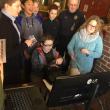Students safely try unsafe driving
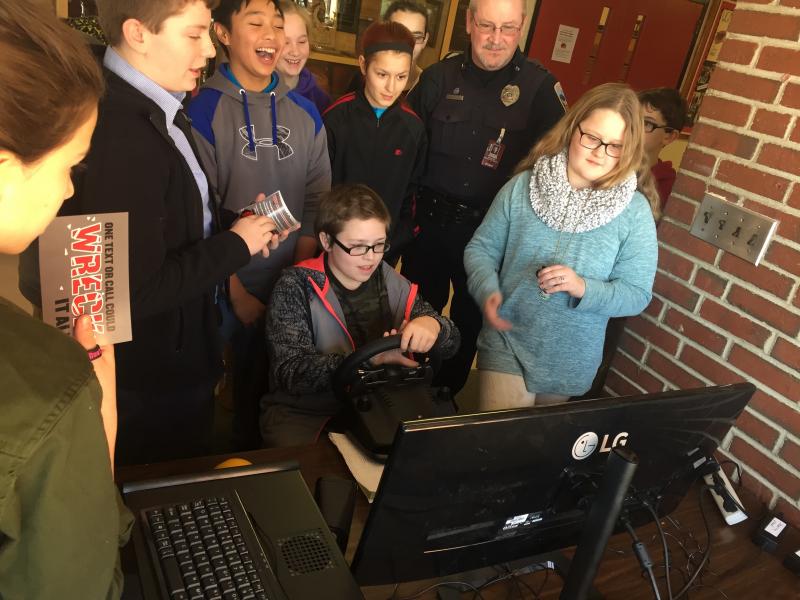 WMHS seventh grader Chris Carr uses a driving simulator Jan. 21 as other students and School Resource Officer Tom Hoepner look on. SUSAN JOHNS/Wiscasset Newspaper
WMHS seventh grader Chris Carr uses a driving simulator Jan. 21 as other students and School Resource Officer Tom Hoepner look on. SUSAN JOHNS/Wiscasset Newspaper
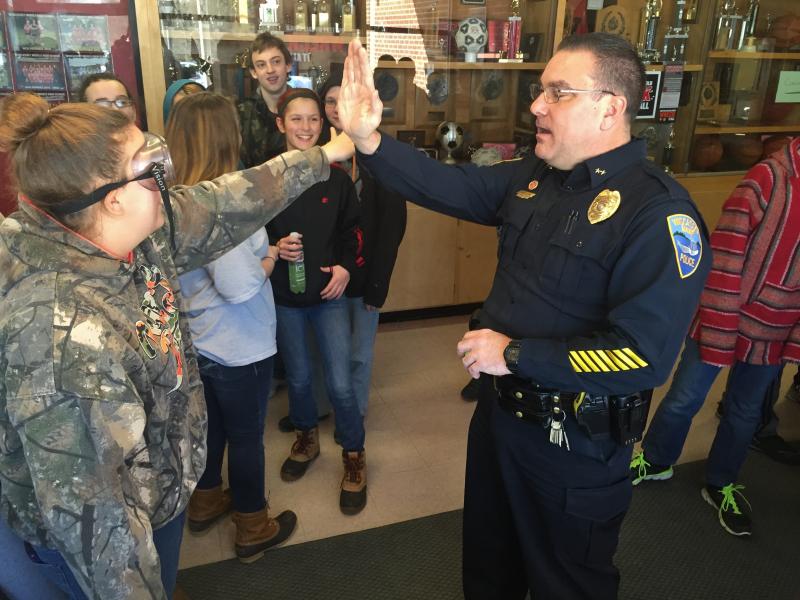 WMHS seventh grader Joanna Collins attempts a high five with Wiscasset Police Chief Troy Cline on Jan. 21 while she has on goggles that simulate impairment. Story on the “Dare to Prepare” teen driving safety program, page 1. SUSAN JOHNS/Wiscasset Newspaper
WMHS seventh grader Joanna Collins attempts a high five with Wiscasset Police Chief Troy Cline on Jan. 21 while she has on goggles that simulate impairment. Story on the “Dare to Prepare” teen driving safety program, page 1. SUSAN JOHNS/Wiscasset Newspaper
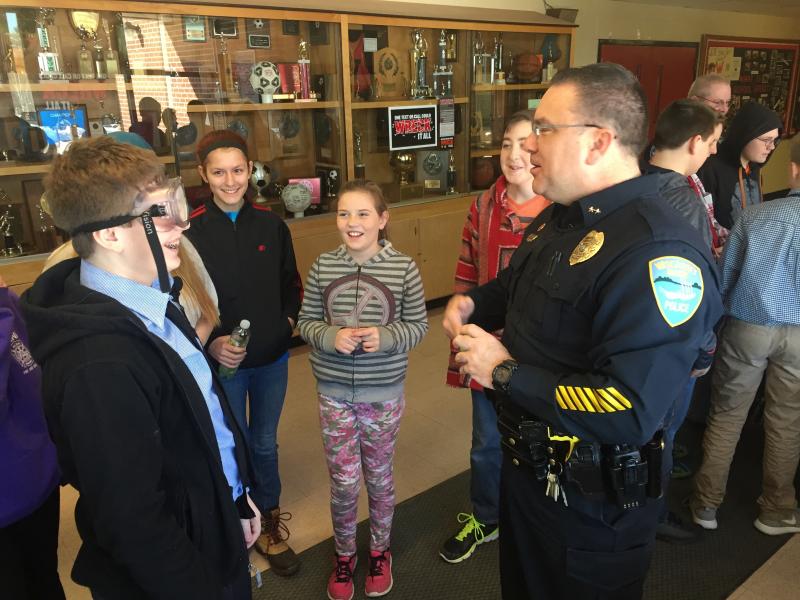 Seventh grader Dalton Roy listens Jan. 21 as Cline talks about the goggles Roy has on. SUSAN JOHNS/Wiscasset Newspaper
Seventh grader Dalton Roy listens Jan. 21 as Cline talks about the goggles Roy has on. SUSAN JOHNS/Wiscasset Newspaper
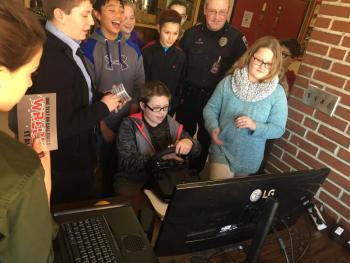 WMHS seventh grader Chris Carr uses a driving simulator Jan. 21 as other students and School Resource Officer Tom Hoepner look on. SUSAN JOHNS/Wiscasset Newspaper
WMHS seventh grader Chris Carr uses a driving simulator Jan. 21 as other students and School Resource Officer Tom Hoepner look on. SUSAN JOHNS/Wiscasset Newspaper
 WMHS seventh grader Joanna Collins attempts a high five with Wiscasset Police Chief Troy Cline on Jan. 21 while she has on goggles that simulate impairment. Story on the “Dare to Prepare” teen driving safety program, page 1. SUSAN JOHNS/Wiscasset Newspaper
WMHS seventh grader Joanna Collins attempts a high five with Wiscasset Police Chief Troy Cline on Jan. 21 while she has on goggles that simulate impairment. Story on the “Dare to Prepare” teen driving safety program, page 1. SUSAN JOHNS/Wiscasset Newspaper
 Seventh grader Dalton Roy listens Jan. 21 as Cline talks about the goggles Roy has on. SUSAN JOHNS/Wiscasset Newspaper
Seventh grader Dalton Roy listens Jan. 21 as Cline talks about the goggles Roy has on. SUSAN JOHNS/Wiscasset Newspaper
Wiscasset Middle High School seventh grader Joanna Collins already knew people weren’t supposed to drink and drive, or text and drive.
“But I never knew what it felt like,” she said Jan. 21.
“It isn’t very fun,” fellow seventh grader Brooke Thayer said.
Collins agreed.
The two and other students in their lunch period had just been joining Wiscasset police in a set of exercises with equipment that shows what substances do to sight and other functions, and just how quickly a drive can go wrong due to texting.
“The whole point is to educate kids on the fact it only takes a second, or sometimes less than a second, for something bad to happen,” Chief Troy Cline said.
School Resource Officer Tom Hoepner approached Cline with the idea to borrow special goggles and a driving simulator free from the Maine Department of Public Safety’s Bureau of Highway Safety. The bureau partners with AAA to offer the “Dare to Prepare” program.
“I said absolutely,” Cline said. “I wished we’d done it in previous years.”
Seven percent of license-holders are teens, but they are involved in 14 percent of all fatal crashes, Cline said, citing statistics from the program.
WMHS students also received rings to wear to remind them not to text while driving; and a pair of cards with bulleted facts. Vehicle crashes kill more teens in the U.S. than anything else does; and a texting driver is 23 times more likely to crash, the cards state.
Wiscasset’s school resource officer program is in its second year; the police department is trying to incorporate more things that will interest students, such as the loaned goggles and driving simulator, Cline said.
Police had the items in the school lobby for seventh through twelfth graders to try and retry during lunch Jan. 20, 21 and 22.
The program was succeeding in capturing students’ interest, according to Principal Peg Armstrong. They were talking about it a lot, Armstrong said in the lobby Jan. 21.
“I think it’s great. It’s raising their awareness of the dangers and it gives them an opportunity to experience things themselves,” Armstrong said.
The driving simulator had a wheel and pedals to negotiate a route on a computer screen, and a mouse for texting or for dialing a number a passenger is dictating. Students had to try to obey stop signs, stay off the center line and out of a bike lane, and follow the passenger’s directions on where to turn. Distracted or drunk driving, which the program also simulates, spurred accidents.
The goggles, called “fatal goggles,” Cline said, give the effect of impairment. Before each student donned them, Cline warned that they might make the student feel dizzy.
If that happened, the student was to remove the goggles and tell Cline, who was leading them through the exercise. When he asked for high fives, most students either missed his hand or caught only part of it.
To a reporter trying the goggles on, the view looked like a funhouse mirror.
“I kind of lost my balance,” seventh grader Riley Trask said about her experience with the goggles.
Cline kept the exercise fun, for the wearer and students looking on. “Dude, it’s not that hard,” Cline said after seventh grader Dalton Roy missed a high five.
“Boy you guys are horrible with those goggles,” Cline said at another point.
He was smiling when he said it. Students were smiling and laughing a lot during the session, as were those over at the driving simulator with Hoepner.
That’s another benefit to programs like “Dare to Prepare” and to having police spend time in the schools, according to Cline.
“The chief has a reputation in town for being the hard guy, so the more things like this we can do, the better, where students can interact with police in a positive manner,” he said.
Event Date
Address
United States




